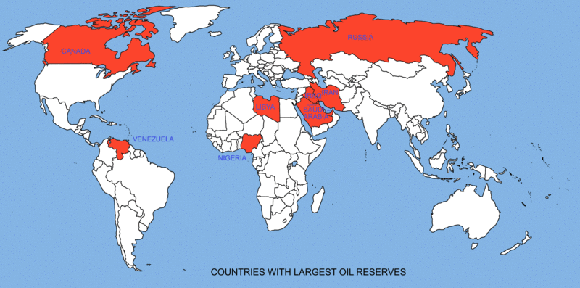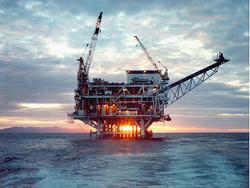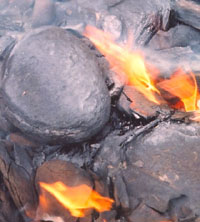Oil
Putting gasoline in your car is not the only thing you need to do with your car to make it run. You also need to change the oil on a regular basis to keep your engine in top shape. Since gasoline is also derived from oil, your car is consuming fossil fuels in multiple ways.
So how does this oil get from underground to your gas tank? Click through the tabs to learn more about oil formation, storage, refining, and use.
Oil Formation

Petroleum or crude oil, as it is called when it first comes out of the ground, forms from the decaying remains of plankton and marine animals that lived 100 to 500 million years ago. When tiny sea organisms die, they are buried under layers of silt and sand on the ocean floor. As the remains became buried deeper and deeper over time, the enormous heat and compression turns them into oil. Oil deposits are buried deep beneath layers of soil and rock in ancient marine sediments. They are not always under water; they could have been formed in areas that were once under ancient seas but are dry land today. We use special drills to extract the oil from beneath the surface for fuel.
Crude oil is a thick, gooey liquid containing hundreds of combustible hydrocarbons, which are molecules that contain carbon and that burn easily. The hydrocarbons are derived from the bodies of the organisms from which the oil formed. Crude oil also contains smaller amounts of sulfur, oxygen, and nitrogen.
Oil reserves

An oil reserve is an identified deposit from which crude oil can be extracted for a profit. The map shows you where major oil reserves are located. The largest exporter of oil in the world is Saudi Arabia Total worldwide known reserves of oil are about 3.7 trillion barrels.
China, the United States, and Japan are the three biggest oil users. In the U.S., we produce about nine percent of the world’s oil, but use about 25 percent of it. Thus, we import a large portion of our oil from other countries. Japan and China also import huge amounts of oil. In fact, Japan imports 90 percent of the oil it consumes.
Currently, oil is consumed at about 84 million barrels per day. If this consumption rate remains the same, estimates indicate that we may begin to run out of oil around 2038. Some factors that could extend our oil supply, or make it last longer, include:
- new discoveries of previously unknown oil reserves
- energy conservation (would mean less need for oil to produce energy)
- more use of renewable energy, or energy not derived from fossil fuels (e.g., solar power, wind power, etc.)
Factors that could decrease our oil supply, or make it run out faster, include:
- increased demand from China and other rapidly developing nations
- increased industrial and transportation needs from a growing human population
Oil refining

After we extract oil from Earth, we use it to make everything from automotive oil to plastics to asphalt, grease and wax. Most of the products we use in daily life are somehow connected to oil. The oil industry is the world’s largest business. As shown in the diagram, oil refining is the process whereby we heat crude oil to different temperatures to make different useful products. For example, automotive gasoline forms when we heat crude oil to about 150° C, and kerosene forms at about 200° C. This refining process is done at an oil refinery plant.
Offshore oil drilling

Offshore oil drilling refers to the exploration for and extraction of oil from under water, near the shoreline. It is common in the Gulf of Mexico and has potential to be a major source of oil for the U.S. in the future. However, it is more costly than land-based oil extraction and has serious environmental impacts. The biggest problem is the damage done to seas by oil spills. The oil is deadly to marine organisms. Offshore drilling has been banned along many U.S. shores, but in July 2008, U.S. President George W. Bush wanted to lift, or stop, this ban because of rising oil prices, and the demand from many citizens to find new sources of American oil. However, lifting the band required Congressional approval, which it did not receive. In March 2010, newly-elected U.S. President Barack Obama also pushed Congress to lift the ban on offshore drilling, citing the need to find more sources of American oil so the U.S. could be less dependent on other countries to supply the oil. President Obama announced plans to open parts of the Virginia and Florida shorelines to offshore oil drilling.
Oil Sands and Oil Shale

Oil sands are mixtures of sand or clay and extremely thick deposits of a form of petroleum, called bitumen. They are found in large amounts throughout the world, especially in Canada and Venezuela. Oil sands have only recently been considered part of the world’s oil reserves as new technology has made their extraction easier. You will sometimes hear the term "conventional oil." This refers to crude oil deposits of regular petroleum. Oil sands are considered non-conventional oil. Extracting and processing oil sands has a severe impact on the land; the process produces toxic waste, and pollutes air and water. But oil sands have the advantage of potentially expanding our oil supply.
Oil shale is another non-conventional source of oil. These are oily rocks that contain a solid combustible mixture of hydrocarbons, called kerogen. When heated, Kerogen can be extracted from the crushed rock. About half of the world’s oil shale deposits are in the western U.S. Some scientists estimate that these deposits could meet the U.S. demand for oil for more than 100 years. The drawbacks of oil shale include the high cost of extracting them and the water and air pollution when they are extracted and burned.